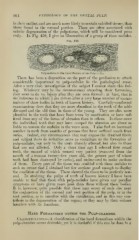Page 854 - My FlipBook
P. 854
864 PATHOLOGY OF THE DENTAL PULP.
in their outline, and are much more likely to contain calcified tissues, than
those found in the coronal portion. These are often associated with
calcific degeneration of the pulp-tissue, which will be considered pres-
ently. In Fig. 459, I give an illustration of a group of these nodules.
Fig. 459.
Pulp-nodules in the Canal Portion of the Pulp (X o'J).
There has been a disposition on the part of the profession to attach
considerable importance to pulp-nodules in the pathological sense.
After a very close investigation of the subject I cannot share this feel-
ing. Whatever may be the circumstances attending their formation,
they seem to do no injury after they are once formed ; at least, that is
the inference to which I am driven after a very large number of exami-
nations of these bodies in teeth of known history. Carefully-conducted
examinations show that they are more abundant in the teeth of the mid-
dle-aged and the old than in those of the young. They are also more
plentiful in the teeth that have been worn by mastication or have suf-
fered from any of the forms of abrasion than in others. In these cases
the individual teeth that may have escaped the abrasion are about as
liable to contain the nodules as the worn ones. I also find an increased
number in teeth from mouths of persons that have suffered much from
caries. Indeed, any circumstances that may expose the dentinal fibrils
and subject them to irritation seem to contribute to the formation of
pulp-nodules, not only in the teeth directly affected, but also in those
that are not affected. Only a short time ago I selected four sound
teeth, the enamel of which seemed very perfect (removed from the
mouth of a woman twenty-five years old, the greater part of whose
teeth had been destroyed by caries), and endeavored to make sections
of them. Every part of the tissue was studded with these nodules to
such an extent that I obtained but few sections good enough to display
the condition of the tissue. These showed the tissue to be perfectly nor-
mal. In studying the pulps of teeth of known history I have been
unable to find that those with pulp-nodules have given any peculiar
symptoms or have given more pain than those without these bodies.
It is, however, quite possible that these may occur of such size near
the conjunction of the coronal and root portion of the pulp, or in the
root portion, as to interfere with the circulation, and in this way con-
tribute to the degeneration of the organ; or they may by their volume
interfere with its functions.
Hard Formations within the Pulp-chamber.
Classification.—A classification of the hard formations within the
pulp-chamber seems desirable, yet it is doubtful if tliis can be done in a


